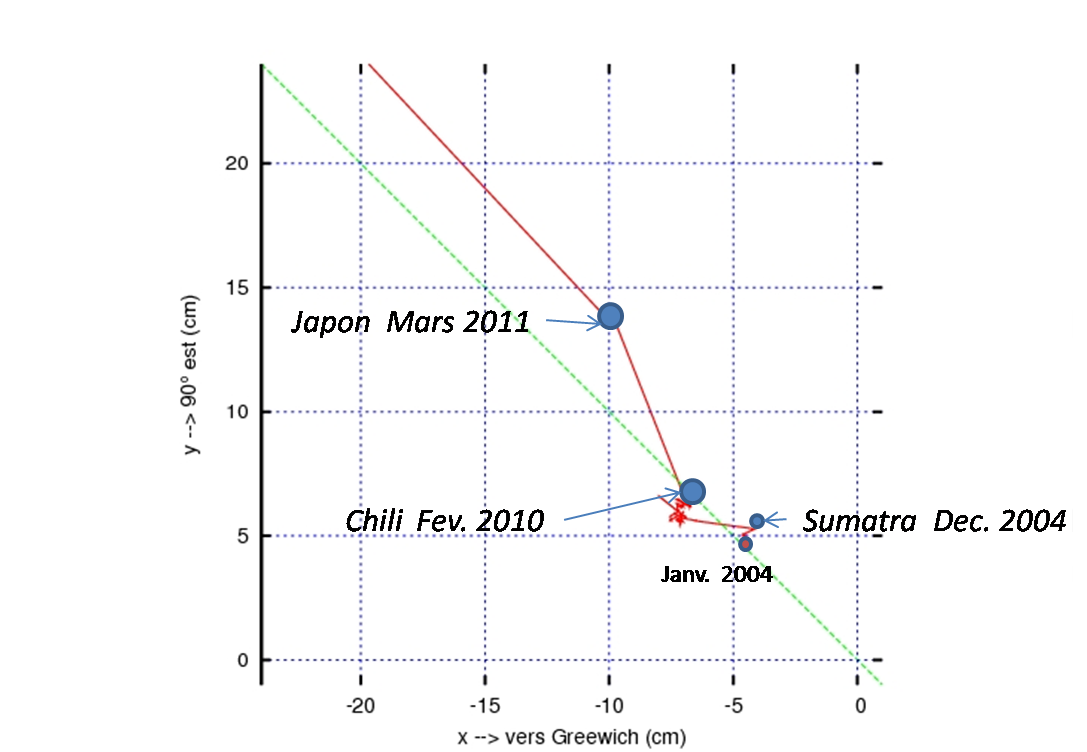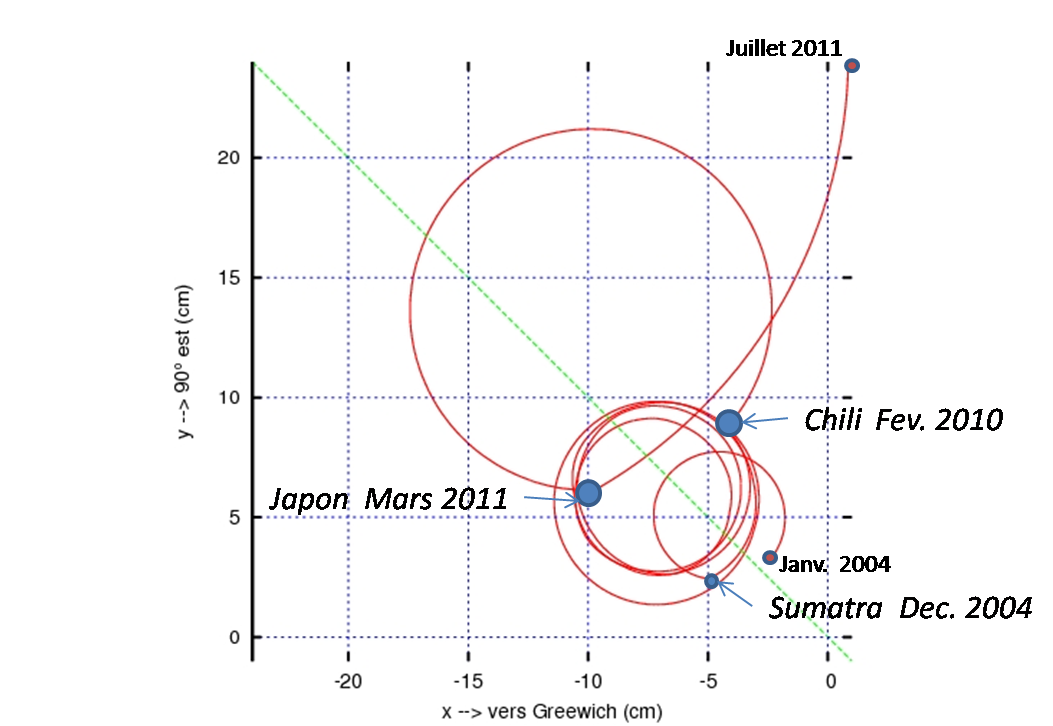
Modeled co-seismic shift of the rotation pole since January 2004:

C. Bizouard, S. Lambert, D. Gambis, J. Y. Richard, O. Becker. Service International de la Rotation de la Terre & Centre d'Analyse IVS
![]()
![]() February 2011: Implementation of the IERS 08 C04 system on 1 February 2011
February 2011: Implementation of the IERS 08 C04 system on 1 February 2011
The IERS has implemented the ITRF 2008 and made it available in its EOP products on 1 February 2011. The official IERS 08 C04 solution is available at ftp://hpiers.obspm.fr/iers/eop/eopc04 and the Rapid Service/Prediction Center solution is available at ftp://maia.usno.navy.mil/ser7/. Users are advised to update their data from these sites on 1 February to ensure that they are fully consistent with the new 08 C04 system. The former 05 C04 solution will be stopped on June 2011.
D. Gambis, C. Bizouard, Earth Orientation Center, Paris Observatory
B. Luzum, N. Stamatakos, IERS Rapid Service/Predictions Center,
![]() March 2010 : The Chile Earthquake of February 27th, 2010 of magnitude 8.8 has caused no DETECTABLE effect on the rotation pole and rotation rate. Independently of Earthquake, rotation pole moves of some mm up to several cm per day because of continuous atmospheric, oceanic and hydrologic mass transport. Till now the effect of Earthquake remains a theoretical matter. According to the seismic models, the recent Chile event will have the effect of disturbing the rotation pole by 8 cm in some months, small amount in comparison with the path a few meters it will achieve during this period. By handling atmospheric, oceanic and hydrologic data, this path will be modelled with a mean error of 50 cm, so that the tiny seismic effect will probably remain undiscernible. The Chile earthquake, would also have decrease the length of day, as high as 2 microseconds, that is to say below the current error on this quantity (10 microseconds), and much lower than the daily variation sometimes coming to 50 microseconds, and mainly caused by winds.
March 2010 : The Chile Earthquake of February 27th, 2010 of magnitude 8.8 has caused no DETECTABLE effect on the rotation pole and rotation rate. Independently of Earthquake, rotation pole moves of some mm up to several cm per day because of continuous atmospheric, oceanic and hydrologic mass transport. Till now the effect of Earthquake remains a theoretical matter. According to the seismic models, the recent Chile event will have the effect of disturbing the rotation pole by 8 cm in some months, small amount in comparison with the path a few meters it will achieve during this period. By handling atmospheric, oceanic and hydrologic data, this path will be modelled with a mean error of 50 cm, so that the tiny seismic effect will probably remain undiscernible. The Chile earthquake, would also have decrease the length of day, as high as 2 microseconds, that is to say below the current error on this quantity (10 microseconds), and much lower than the daily variation sometimes coming to 50 microseconds, and mainly caused by winds.
Alone a mega-seism, such that of Chile in 1960, could cause a visible effect with the modern geodetic techniques.
![]() March 2009 : WEB tool generating tidal variations in LOD, UT1 and Earth angular velocity.
March 2009 : WEB tool generating tidal variations in LOD, UT1 and Earth angular velocity.
![]() February
2009 : Many improvements have been brought on the site. See in particular
the comparison C04 - individual EOP. We propose a new version of Bulletin B, available on ftp://hpiers.obspm.fr/iers/bul/bulb_new/.
February
2009 : Many improvements have been brought on the site. See in particular
the comparison C04 - individual EOP. We propose a new version of Bulletin B, available on ftp://hpiers.obspm.fr/iers/bul/bulb_new/.
![]() November 2007
: WEB Service has been opened. We provide two executables (Linux/DOS)
to be called in any procedure (Fortran/C/php/Perl) : i) download of EOP
C04 parameter at a given date ; ii) the computation of the Earth Orientation
matrix (between ITRF and ICRF) at any instant.
November 2007
: WEB Service has been opened. We provide two executables (Linux/DOS)
to be called in any procedure (Fortran/C/php/Perl) : i) download of EOP
C04 parameter at a given date ; ii) the computation of the Earth Orientation
matrix (between ITRF and ICRF) at any instant.
![]() Summer 2007 :
the WEB site has been updated : analysis / comparison of EOP series
(all VLBI series are given with the celestial pole offsets dX, dY referred
to IAU 2000 model) ; interactive
analysis of the excitation takes now into account the oceanic forcing
(ECCO model).
Summer 2007 :
the WEB site has been updated : analysis / comparison of EOP series
(all VLBI series are given with the celestial pole offsets dX, dY referred
to IAU 2000 model) ; interactive
analysis of the excitation takes now into account the oceanic forcing
(ECCO model).
![]() June 2006 :
EOPC04 : IMPROVED VERSION CONSISTENT WITH ITRF
June 2006 :
EOPC04 : IMPROVED VERSION CONSISTENT WITH ITRF
![]() December 2005 :
EOPC04 : IMPROVED / EXPERIMENTAL VERSION
December 2005 :
EOPC04 : IMPROVED / EXPERIMENTAL VERSION
![]() October 2005 : The atmospheric excitation of the Polar motion and lenght-of-day is available up to the last week.
October 2005 : The atmospheric excitation of the Polar motion and lenght-of-day is available up to the last week.
![]() July 2005 : The Earth orientation Center at the Paris Observatory has decided to introduce
a leap second on 31 december
2005, 23h59min59s UTC. No leap second was added during the last 6 years,
since 31 december 1998, because of strong decadal acceleration of the Earth
rotation (which seems presently to be over).
July 2005 : The Earth orientation Center at the Paris Observatory has decided to introduce
a leap second on 31 december
2005, 23h59min59s UTC. No leap second was added during the last 6 years,
since 31 december 1998, because of strong decadal acceleration of the Earth
rotation (which seems presently to be over).
![]() February 2005 :
February 2005 :
![]() November
2003 : Interactive
comparison of the EOP series
November
2003 : Interactive
comparison of the EOP series
![]() October 2003
: Time
series of the Earth orientation matrix / precession-nutation matrix /
instantaneous rotation vector
October 2003
: Time
series of the Earth orientation matrix / precession-nutation matrix /
instantaneous rotation vector
![]() September 2003 :Interactive
Analysis of the EOP (FFT, least-square estimates, filtering)
September 2003 :Interactive
Analysis of the EOP (FFT, least-square estimates, filtering)
![]() July
2003 : Atmospheric excitation of the nutation (interactive tool)
July
2003 : Atmospheric excitation of the nutation (interactive tool)
![]() June 2003 : Excitation
functions of the Polar motion and lenght-of-day (interactive tool)
June 2003 : Excitation
functions of the Polar motion and lenght-of-day (interactive tool)
![]() Mai 2003 : Rotation
matrix from the international terrestrial reference frame to the international
celestial reference frame, UT1-UTC real time on line (see home page)
Mai 2003 : Rotation
matrix from the international terrestrial reference frame to the international
celestial reference frame, UT1-UTC real time on line (see home page)
![]() April
2003 : Interactive
tool for the selection of EOP parameters and their plots (series C04
and C01).
April
2003 : Interactive
tool for the selection of EOP parameters and their plots (series C04
and C01).
![]() April 2003 :
Table of the available EOP
on this server (combined, operational, long term)
April 2003 :
Table of the available EOP
on this server (combined, operational, long term)
![]() January
2003 : As the IERS follows the conventions UAI 2000 from the 1/1/2003,
changes have been introduced in our products. We provide alternative
C04 series where the celestial pole offsets are given with respect to
the UAI 2000 nutation model by the parameter (dX,dY)
January
2003 : As the IERS follows the conventions UAI 2000 from the 1/1/2003,
changes have been introduced in our products. We provide alternative
C04 series where the celestial pole offsets are given with respect to
the UAI 2000 nutation model by the parameter (dX,dY)